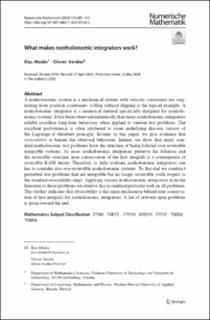| dc.contributor.author | Modin, Klas | |
| dc.contributor.author | Verdier, Olivier | |
| dc.date.accessioned | 2020-12-07T12:26:09Z | |
| dc.date.available | 2020-12-07T12:26:09Z | |
| dc.date.created | 2020-08-29T12:58:31Z | |
| dc.date.issued | 2020 | |
| dc.identifier.citation | Modin, K., & Verdier, O. (2020). What makes nonholonomic integrators work? Numerische Mathematik, 145(2), 405–435. | en_US |
| dc.identifier.issn | 0029-599X | |
| dc.identifier.uri | https://hdl.handle.net/11250/2712178 | |
| dc.description.abstract | A nonholonomic system is a mechanical system with velocity constraints not originating from position constraints; rolling without slipping is the typical example. A nonholonomic integrator is a numerical method specifically designed for nonholonomic systems. It has been observed numerically that many nonholonomic integrators exhibit excellent long-time behaviour when applied to various test problems. The excellent performance is often attributed to some underlying discrete version of the Lagrange–d’Alembert principle. Instead, in this paper, we give evidence that reversibility is behind the observed behaviour. Indeed, we show that many standard nonholonomic test problems have the structure of being foliated over reversible integrable systems. As most nonholonomic integrators preserve the foliation and the reversible structure, near conservation of the first integrals is a consequence of reversible KAM theory. Therefore, to fully evaluate nonholonomic integrators one has to consider also non-reversible nonholonomic systems. To this end we construct perturbed test problems that are integrable but no longer reversible (with respect to the standard reversibility map). Applying various nonholonomic integrators from the literature to these problems we observe that no method performs well on all problems. This further indicates that reversibility is the main mechanism behind near conservation of first integrals for nonholonomic integrators. A list of relevant open problems is given toward the end. | en_US |
| dc.language.iso | eng | en_US |
| dc.publisher | Springer | en_US |
| dc.rights | Navngivelse 4.0 Internasjonal | * |
| dc.rights.uri | http://creativecommons.org/licenses/by/4.0/deed.no | * |
| dc.title | What makes nonholonomic integrators work? | en_US |
| dc.type | Peer reviewed | en_US |
| dc.type | Journal article | en_US |
| dc.description.version | publishedVersion | en_US |
| dc.rights.holder | © The Author(s) 2020 | en_US |
| dc.subject.nsi | VDP::Matematikk og Naturvitenskap: 400::Matematikk: 410 | en_US |
| dc.source.pagenumber | 405-435 | en_US |
| dc.source.volume | 145 | en_US |
| dc.source.journal | Numerische Mathematik | en_US |
| dc.source.issue | 2 | en_US |
| dc.identifier.doi | 10.1007/s00211-020-01126-y | |
| dc.identifier.cristin | 1825889 | |
| cristin.ispublished | true | |
| cristin.fulltext | original | |
| cristin.qualitycode | 2 | |

